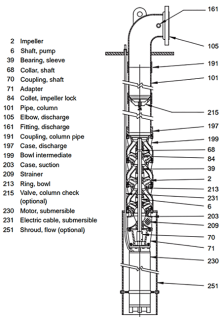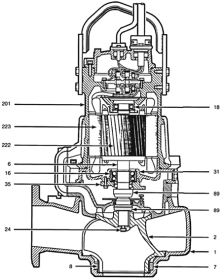
Is there a definition available for submersible pumps?
Generally, the definition of a submersible pump will include a pump/motor unit that is designed to operate while submerged in the pumped liquid. There are two main types of submersible rotodynamic pumps:

Vertically suspended submersible pump (VS0, Image 1):
Vertically suspended submersible pumps have a submersible motor connected to the pump assembly, which is commonly multiple stages and referred to as a bowl assembly. The bowl assembly directs flow through an attached column to a discharge elbow at the surface. This type of pump is typically used in a drilled well to bring groundwater to the surface and occasionally for wet pit or canned booster service.
Overhung close coupled submersible pump (OH8):
These pumps have a single-stage overhung impeller, are close coupled to a submersible electric motor and can either be diffuser type (OH8) or volute type (OH8b, Image 2).

These pumps are commonly designed for use in solids handling applications, such as municipal wastewater.
For more information on submersible pumps, refer to ANSI/HI 14.1-14.2 Rotodynamic Pumps for Nomenclature and Definitions available at pumps.org.

